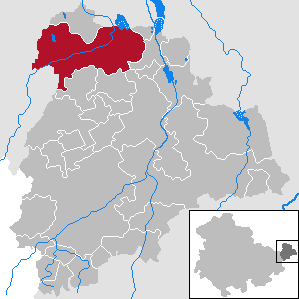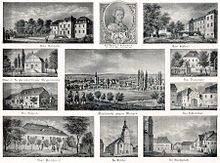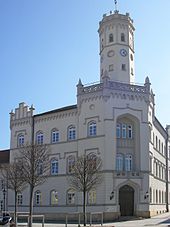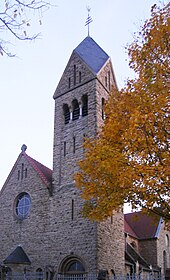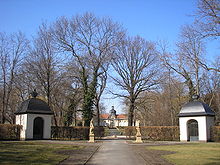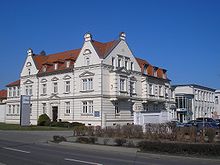Meuselwitz
| coat of arms | Germany map | |
|---|---|---|

|
Coordinates: 51 ° 3 ' N , 12 ° 18' E |
|
| Basic data | ||
| State : | Thuringia | |
| County : | Altenburger Land | |
| Height : | 170 m above sea level NHN | |
| Area : | 53.65 km 2 | |
| Residents: | 9954 (Dec. 31, 2019) | |
| Population density : | 186 inhabitants per km 2 | |
| Postal code : | 04610 | |
| Area code : | 03448 | |
| License plate : | ABG, SLN | |
| Community key : | 16 0 77 032 | |
| LOCODE : | DE MWZ | |
| City structure: | Core city and 10 districts | |
City administration address : |
Rathausstrasse 1 04610 Meuselwitz |
|
| Website : | ||
| Mayor : | Udo Pick (BfM) | |
| Location of the city of Meuselwitz in the Altenburger Land district | ||
After Altenburg and Schmölln, Meuselwitz is the third largest city in the Altenburger Land district in Thuringia and the third largest municipality in the district in terms of area. The small town lies in the border triangle with Saxony and Saxony-Anhalt on the southern edge of the Leipzig lowland bay between Altenburg in the southeast and Zeitz in the northwest and Gera in the southwest and Leipzig in the northeast.
Since the 17th century, the place was initially shaped by the work of the von Seckendorff family , but from 1860 on, Meuselwitz transformed into an industrial town of lignite . Various buildings worth seeing have been preserved from both times, the first includes the orangery and the park as well as the city church in baroque style and the latter the neo-Gothic town hall from 1874. Since that year Meuselwitz also has city rights.
Part of the city was destroyed by bombing raids in 1944 and 1945 and 250 people lost their lives.
geography
Neighboring communities
Adjacent communities, clockwise, are the city of Lucka , Haselbach , Treben , Gerstenberg , the district town of Altenburg, Rositz and Kriebitzsch in the Altenburger Land district, as well as Regis-Breitingen in the Saxon district of Leipzig in the north and Elsteraue in the west and the city of Zeitz in the Saxony-Anhalt Burgenland district .
City structure
In addition to the core city with the historic district of Zipsendorf, Meuselwitz includes the following districts, starting from the north in a clockwise direction:
- Falcon Grove
- Bünauroda
- Schnauderhainichen
- Winter village
- Waltersdorf
- Neubraunshain
- Neupoderschau
- Brossen
- Mumsdorf
The districts of Mumsdorf, Schnauderhainichen and Wintersdorf have their own local mayors. The hamlet Winterdorf include three fused with the main town places Heukendorf , compulsory village and Gröba and Waltersdorf with Neubraunshain and almost completely dredged 1954-1957 Ruppersdorf . Bosengröba was incorporated into Wintersdorf in 1957. Lehma with the district Trebanz belonged to Wintersdorf since January 1, 1996, but were reclassified to Treben on December 30, 2008.
history
12th century to early 20th century
Today's Meuselwitz was first mentioned in 1139 as the manor "Mizleboze". At the beginning of the 15th century, the estate was owned by the Lords of Bünau and , from 1578, by the Cramer von Clausagh emigrant family .
In 1676 Gut Meuselwitz was acquired by Veit Ludwig von Seckendorff , who had Meuselwitz Castle rebuilt in 1677 . The aristocratic market town of Meuselwitz belonged to the Wettin office of Altenburg , which from the 16th century was under the sovereignty of the following Ernestine duchies due to several divisions in the course of its existence : Duchy of Saxony (1554 to 1572), Duchy of Saxony-Weimar (1572 to 1603), Duchy Saxe-Altenburg (1603 to 1672), Duchy of Saxe-Gotha-Altenburg (1672 to 1826). When the Ernestine Duchies were reorganized in 1826, Meuselwitz again became part of the Duchy of Saxony-Altenburg. At that time Meuselwitz was in the northwest of the duchy. The current districts of Zipsendorf , Brossen , Falkenhain and Rusendorf belonged to the Naumburg-Zeitz monastery until 1815 , which was under the sovereignty of the Electorate of Saxony. With the Congress of Vienna they were ceded to Prussia , making Mumsdorf in Saxony-Altenburg an exclave in Prussian territory. The current districts of Ruppersdorf and Bosengröba belonged to the Kingdom of Saxony at that time (until 1806 to the Electorate of Saxony ).
The town hall was built in 1861/1862, a public water supply followed in 1874. In that year, Meuselwitz was granted town charter by Duke Ernst I of Saxony-Altenburg . After the administrative reform in the Duchy of Saxony-Altenburg, Meuselwitz belonged to the Eastern District (until 1900) and to the Altenburg District Office (from 1900). From 1879 the city was under the jurisdiction of the Altenburg District Court until 1906, when the Meuselwitz District Court was established as a separate judicial district.
From 1918 Meuselwitz belonged to the Free State of Saxony-Altenburg , which was added to the State of Thuringia in 1920. In 1922 the city became part of the Altenburg district . This year, Schnauderhainichen was the first place that was incorporated into Meuselwitz.
Period of National Socialism, World War II and the post-war period
The Jewish department store Fruchtmann was destroyed in the November pogrom in 1938. Numerous Jews were deported to the extermination camps, others emigrated to Palestine and other countries. During the Second World War there were the forced labor camps Meuselwitz I-III and V as well as the Gasthof Lindenhof, Heymer & Pilz and Karl Julius Görler, which housed a large number of prisoners of war and forced laborers who were housed in the “ Phönix ” pit in Mumsdorf and at the HASAG plant in Meuselwitz, which was subordinate to the Buchenwald concentration camp as an external command, had to do forced labor. Many lost their lives as a result of the catastrophic working and living conditions, and some were killed in a bomb attack. The surviving Jewish women were sent on a death march by the SS , the men were driven to Theresienstadt . At the Mumsdorf Cemetery of Honor, which was laid out under the supervision of the US Army , 290 dead who were found in mass graves are remembered.
Meuselwitz was hit twice by heavy air raids during World War II , on November 30, 1944 (US Air Force) and on February 20, 1945 (British Bomber Command). The first attack dropped 54 tons of bombs, the second 140 tons, including seven air mines and 550 five-quintals. More than 250 people died in these attacks, 42 of whom were forced laborers. 3000 Meuselwitzers were homeless after the second attack. Meuselwitz gave the impression of a " ghost town ". In both air strikes, 85 percent of the buildings in the entire city were completely destroyed or moderately to slightly damaged. It is often wrongly assumed that 85% of Meuselwitz was destroyed.
On April 17, 1945, American troops moved into Meuselwitz. At the beginning of July they were replaced by the Red Army . Thus Meuselwitz - like all of Thuringia - became part of the SBZ and in 1949 the GDR .
The castle was only damaged in the bombardment on February 20, 1945 , but after the war and as part of the land reform it was blown up and demolished . The orangery burned down, its dome collapsed in 1954 (for more see sights) The preserved baroque castle gate and the historic farm buildings (damaged in the air raid) were also removed.
In 1950, two teachers and two students from the Meuselwitz Oberschule were sentenced to death by a Soviet military tribunal in Weimar and executed in Moscow on charges of forming a "resistance group" . In 1952, an “anti-Soviet group” of former students was arrested again. Two of them (and one other man) were sentenced to death by a military tribunal in Potsdam and executed in Moscow. Several other former students received long-term labor camp sentences in a Soviet gulag . In 1995/96 the condemned were officially rehabilitated by the Russian Federation . A memorial stone in front of the Veit-Ludwig-von-Seckendorff-Gymnasium with the inscription: “In memory of the victims of the communist dictatorship and the resistance at our school” (the names of three of those killed follow) commemorates the event. There is also an exhibition designed by the students in the grammar school.
1950 to the present
With the first administrative reform in the GDR in 1950 Meuselwitz was assigned to the Thuringian district of Altenburg. At the same time Bünauroda was incorporated. Mumsdorf, which was previously a Thuringian exclave, came to the Zeitz district in the state of Saxony-Anhalt .
With the second regional reform in the GDR in 1952, Meuselwitz was assigned to the Altenburg district in the Leipzig district . Ruppersdorf and Bosengröba moved from Borna district to Altenburg district. On December 4, 1952, the communities Zipsendorf with Brossen, Mumsdorf and Falkenhain moved with the corridor of Rusendorf from the Zeitz district in the Halle district to the Altenburg district, which increased the area around Meuselwitz in the west and north. In 1973 Zipsendorf was incorporated with Brossen and Neupoderschau.
When the Free State of Thuringia was re-established in 1990, Meuselwitz was incorporated into the Thuringian district of Altenburg. In 1993 Mumsdorf was incorporated and in 1994 Falkenhain with the corridor of Rusendorf. In the same year Meuselwitz came to the Altenburger Land district. The municipality of Wintersdorf with the districts Heukendorf, mandatory village, Gröba, the corridor of Ruppersdorf, Bosengröba, Waltersdorf, Neubraunshain, Trebanz and Lehma was incorporated in 2007. However, Trebanz and Lehma were reclassified to Treben in 2008 .
Meuselwitz Castle and Martinskirche
Today's Meuselwitz was first mentioned in a document as a manor in 1139 as "Mizleboze". At the beginning of the 15th century, the estate was owned by the Lords of Bünau , and from 1578 by the Dutch emigrant family (Cramer) von Clausagh, who set up a fabric manufacture with a weaver's house, fulling mill and dye works here.
In 1676 the estate was acquired by Veit Ludwig von Seckendorff , who was then in the service of Duke Moritz von Sachsen-Zeitz . He had Meuselwitz Castle rebuilt in 1677 , settled in Meuselwitz from 1681 and worked in the then Duchy of Saxony-Gotha -Altenburg as landscape and chief tax director. Between 1724 and 1727 the palace was fundamentally redesigned under the imperial count Friedrich Heinrich von Seckendorff . The existing castle was converted into a four-wing complex by the Leipzig builder David Schatz , with central projections facing the city and the park. The castle had a bastion-like floor plan, the ballroom was characterized by rich painted and plastic decoration. The castle gate to the city was splendidly decorated with trophies. To the right and left of the gate there were two-storey commercial buildings in the style of that time. The rebuilt orangery in the palace garden, which was laid out in 1709 and which was built in 1724, is the only surviving structure in the palace complex after its partial destruction (burned out) by bombing in 1945 and the subsequent demolition of the only slightly damaged palace, the damaged farm buildings and the intact palace gate.
In 1740 the Martinskirche was rebuilt by a Hungarian architect in the style of his homeland.
Lignite mining
Lignite was found near Meuselwitz as early as 1670 . A first attempt to mine lignite underground was made around 1780. After 1860, several large coal deposits north of the city were developed, which were initially exploited underground as piers , but were later opened up on a large scale as opencast mines . One consequence of this was that the population more than doubled between 1842 and 1880.
In the second half of the 19th century, numerous briquette factories continued to emerge around Meuselwitz, the center of the Meuselwitz-Altenburg lignite mining area . Large opencast mines existed until 1968 mainly in the west, north and east of the city with the opencast mines Zipsendorf-West and South , Ruppersdorf and several open-cast mines with the name Phoenix . As a result, the places Rusendorf and Ruppersdorf and part of Schnauderhainichen disappeared in today's urban area . In the 1980s, the resumption of lignite mining was planned, but this was not carried out. Several places in the east and south of Meuselwitz would have had to give way to the planned “opencast mine Meuselwitz” between Meuselwitz and Rositz. After the renaturation of the opencast mines, the Rusendorfer See and the Hainbergsee emerged in the vicinity of Meuselwitz.
Incorporation and population development
Incorporations
After Meuselwitz, Schnauderhainichen was incorporated into its districts in 1922, Bünauroda in 1950, Zipsendorf (with Brossen) and Neupoderschau in 1973, Mumsdorf in 1993, Falkenhain in 1994 and Wintersdorf in 2007. At the end of 2008, Trebanz and Lehma moved to Treben ( Pleißenaue administrative association ).
| Former parish | date | annotation |
|---|---|---|
| Bosengröba | Incorporation to Ruppersdorf | |
| Brossen | 07/01/1950 | Incorporation to Zipsendorf |
| Bünauroda | 07/01/1950 | |
| Falcon Grove | 03/08/1994 | |
| Groeba | 1923 | Incorporation to Wintersdorf |
| Heukendorf | 1923 | Incorporation to Wintersdorf |
| Lehma | 01/01/1996 12/30/2008 |
Incorporation to Wintersdorf, reclassification to Treben |
| Mumsdorf | 10/16/1993 | |
| Neubraunshain | 07/01/1950 | Incorporation to Waltersdorf |
| Neupoderschau | 01/01/1957 01/01/1973 |
Merger with Altpoderschau to Poderschau reclassification to Meuselwitz |
| Village of duty | 1923 | Incorporation to Wintersdorf |
| Ruppersdorf | 01/01/1957 | Incorporation to Wintersdorf |
| Schnauderhainichen | 10/01/1922 | |
| Trebanz | 07/01/1950 12/30/2008 |
Incorporation to Lehma, reclassification to Treben |
| Waltersdorf | 01/01/1973 | Incorporation to Wintersdorf |
| Winter village | December 01, 2007 | |
| Zipsendorf | 01/01/1973 |
Population development
Development of the population (from 1960 December 31) :
|
1583 to 1842
|
1880 to 1994
|
1995 to 2001
|
2002 to 2008
|
2009 to 2015
|
from 2016
|
- Data source from 1994: Thuringian State Office for Statistics
1 October 29
2 August 31
3 December 31 (after incorporation)
politics
City council
Since the local elections on May 26, 2019 , the city council has been composed as follows:
- AfD : 6 seats (+6)
- Independent voter community Wintersdorf (UWW) *: 4 seats (± 0)
- DIE LINKE : 3 seats (−2)
- Citizens for Meuselwitz (BfM): 3 seats (−3)
- CDU : 3 seats (−4)
- New Meuselwitzer Mitte (NMM): 3 seats (+3)
- SPD : 2 seats (± 0)
mayor
Mayor was Johannes Matuszewski (CDU) from 1994 to 2004. In the runoff election on October 24, 2004, the CDU politician Barbara Golder emerged as the winner, who was confirmed in office in 2010. She ended her term of office in 2016. Udo Pick from the Initiative Bürger für Meuselwitz won the runoff election on January 24, 2016, with a turnout of 53.3% (+ 0.7% p compared to the 1st ballot) and a majority of 56, 2%.
coat of arms
Blazon : “Divided by a silver bar from black over blue and shows a silver mallet crossed with a silver hammer at the top and a golden archer at the bottom. The coat of arms is covered by a silver, red-lined, gold-crowned Spangenhelm, on it a red linden leaf loop with four parallel red leaves, the helmet covers are gold-black. "
flag
When it was granted city rights in 1874, the city had the established flag colors black and blue.
Town twinning
There is a city partnership with the city of Lauffen am Neckar .
Culture and sights
- see also: List of cultural monuments in Meuselwitz
Attractions
- The local history museum has been located in Neugasse 1/3 since 1996, in a former weaver's house (around 1700) and one of the oldest buildings in the city. After an emergency backup in October 1993, the renovation began in December 1994. Until 1984 the old mill was used as an exhibition area and later as a storage facility.
- The town hall was built in the years 1861 and 1862 in neo-Gothic style. It has been the mayor's seat since 1874, after Meuselwitz was named town on July 6, 1874. Initially, the mayor's apartment was also located in the town hall. Later on, due to the expansion of the city, the premises were needed as work spaces. For some time the savings bank and the archive were also housed in the town hall. In 1989 the facade was renewed to mark the 850th anniversary of the first mention of the place. The interior of the town hall was renovated in 1993 and 1994. The town house opposite the building was built in the same architectural style. Today the Sparkasse is located in the part facing the market.
- The orangery is located at the end of the palace park , Von-Seckendorff-Park . It is the last part of the former castle complex that is still preserved today, which was hit less by bombing, but harder by subsequent demolitions, including intact or only damaged buildings (including the castle itself). The palace complex belonged to the von Seckendorff family, who had shaped the history of the city for over 269 years. The orangery was built between 1724 and 1727 as part of the expansion of the palace, which presumably came from the council builder Georg Hellbrunn. The drafts of the late baroque building come from the Saxon state master builder David Schatz . Model, the Zwinger of Carl Friedrich Poeppelmann have been. The orangery has a flat arched floor plan, a gate pavilion with a curved dome, oval niches with busts and heavy crowns. The building is said to have served as a template for the Sanssouci Palace , built in 1745 . During the bombing raid on the castle on March 20, 1945, the orangery burned down and its dome collapsed in 1954. After that, security and reconstruction began, and in 1963 the interior was also expanded. The metope fillings were not restored in the exterior construction. Two gatehouses from the 18th century have also been reconstructed. In 1969 the orangery was reopened as a museum and concert hall. From 1991 to 1998 the entire structure was again extensively renovated and saved from deterioration. Since the summer of 1998 there has been a café and restaurant as well as a ballroom in the orangery. The former areas of the removed manor are now used as a parking lot.
- The Hainbergsee was created around 1900 from the former Vereinsglück mine . The lake is about 800 meters long, 300 meters wide and has a water surface of around 18 hectares. In places it is up to 40 meters deep. The good water quality is probably caused by an underground spring. The lake has a large fish population and is inhabited by water birds, including herons , swans and wild geese . It is also used for fishing and recreational sports. The approximately 220 meter high Hainberg borders the lake and is one of the highest elevations around Meuselwitz.
- Another attraction is the Meuselwitz culture station in the former engine shed. A model exhibition is housed there that shows the re-emergence of the Meuselwitz - Altenburg railway line. There is also an open-air exhibition with technical systems and historical trains. The over 100-year history of lignite mining is to be illustrated there. The Kulturbahnhof is also the starting point for the coal railway , a 900 mm narrow-gauge railway.
Other buildings worth seeing are the Martinskirche , the Zipsendorfer Church, the Catholic Church and the water tower. The mill pond, whose old town mill was demolished, and the grotto pond with the shell grotto are also worth a visit.
Monuments
- von Seckendorff monument in the park of the same name, the former palace park.
- Memorial stone (from 1995) for the Meuselwitz bomb victims in the cemetery, who were also buried there in row graves.
- Memorial stone in front of the Veit-Ludwig-von-Seckendorff-Gymnasium to commemorate teachers and pupils of the high school at that time who were sentenced to death and executed by Soviet military tribunals in 1950 and 1952 : "In memory of the victims of the communist dictatorship and the resistance at our school"
- Memorial to the Meuselwitzers who fell in World War I in the cemetery
- Stele on Rathenau-Platz in memory of 25 years of German unity
- Völkerschlachtdenkmal in Wirkerpark. It dates from 1913 and consists of a granite stone with the inscriptions: "1813 - October 18th - 1913" and "Grandchildren may rule vigorously - difficult to obtain"
No longer existing monuments:
- Memorial for those killed in the Franco-German War 1870/71, on Baderdamm. Was demolished in 1965 as part of a new building.
- Monument from 1891 with Kaiser Wilhelm I : on Kaiser-Wilhelm-Platz (today Rathenau-Platz), it was removed in 1946.
- Monument from 1930 for President Friedrich Ebert in the Wirkerpark. It was designed by the Meuselwitz artist Erich Dietz and created by the sculptor Alfred Benkert at the suggestion of the Meuselwitz local group of the Reichsbanner Schwarz-Rot-Gold. Removed in 1933 or after.
societies
In Meuselwitz and its districts there are over 80 cultural and interest groups.
Sports
The regional soccer division ZFC Meuselwitz is based in Meuselwitz . Another football club is FSV Meuselwitz, whose men's team plays in the district league. This club also has an active running and triathlon section. There has been a handball team in Meuselwitz since 1922. The men's team of today's Meuselwitz handball club , which emerged from BSG Motor Meuselwitz , plays its games in the Schnaudertalhalle. In addition, the traditional shooting club PSG Meuselwitz is active in the city .
Economy and Infrastructure
Companies
Structural companies of the Meuselwitz business location are z. B:
- bluechip Computer AG ( notebooks , PCs , servers )
- Meuselwitz Guß Eisengießerei GmbH (cast parts, especially large and heavy castings)
- Maschinenfabrik Herkules Meuselwitz GmbH (machine tools)
- Gummiwerk Meuselwitz GmbH (profiles, hoses, etc.)
- MSB Meuselwitzer Stahlbau GmbH (steel construction, plant construction, special machine construction)
- Hans Glass GmbH & Co. KG (car mats)
traffic
- Railway lines
On April 18, 1872, Meuselwitz received a rail connection with the opening of the Altenburg-Zeitz railway, on September 7, 1874 the railway to Leipzig (Meuselwitz-Gaschwitz) and October 17, 1887, the Meuselwitz – Ronneburg railway was opened. When the Zwenkau and Groitzscher Dreieck opencast mines opened up, the route to Leipzig between Lucka and Groitzsch was interrupted and removed in the 1970s. At the beginning of 2004 the passenger traffic between Altenburg and Zeitz was stopped. On the Zeitz ( Profen ) and Meuselwitz section, coal trains were still running until 2013 to supply the power plant in Mumsdorf and a few trains to the Kriebitzsch gravel recycling plant.
Thus, all of these routes are closed. The Meuselwitz – Haselbach – Regis-Breitingen coal railway is used as a museum.
- bus
A LandesBus line provides a connection from / to Zeitz, where there is a connection to the trains of the Erfurter Bahn and Burgenlandbahn , and a PlusBus line from / to Altenburg, here in turn there is a connection to the trains of the S-Bahn Central Germany and the Regional express of the DB . In addition, there are lines to the surrounding villages which are better connected to public transport. Although Meuselwitz does not have a rail network, the city has the best direct connections to Zeitz, Leipzig, Borna, Altenburg, Dobitschen, Kayna and Groitzsch. The line numbers are 352,356,401,404,405,406,409,412,413,414, + 416,416.
- Streets
Federal highway 180 (Altenburg – Naumburg) and state road 1361 (Schmölln – Lucka) run through the city . Junction 61 Schmölln of the A4 is about 24 km south of Meuselwitz. The A 9 junction 21a Naumburg is around 28 km to the west. About just as far away is junction 31 Leipzig-Süd of the A 38 to the north . In the east it is about 24 km to the A 72 junction Borna-Nord .
education
In Meuselwitz there is a primary school, a regular school , the Veit-Ludwig-von-Seckendorff-Gymnasium (European school) and the drama school of the Thuringia Media Academy, a state-recognized supplementary school.
Personalities
sons and daughters of the town
- Johann Martin Schamelius (1668–1742), Protestant theologian.
- Johann Gottlob Thierbach (1736–1782), rector of the Lyceum in Guben and archaeologist
- Alfred von Seckendorff (1796–1876), majorate, poet lawyer
- Friedrich Bernhard von Seckendorff (1772-1852), politician
- Gustav Anton von Seckendorff (born November 20, 1775, † 1823 in Alexandria (Louisiana)), writer
- Friedrich Karl Forberg (born August 30, 1770; † January 1, 1848 in Hildburghausen), philosopher
- Ferdinand Ignaz Herbst (born December 20, 1798 - † May 11, 1863 in Munich), Roman Catholic theologian and clergyman
- Gustav Friedrich Held (born May 29, 1804; † April 24, 1857 in Dresden), lawyer and politician
- Viktor von Ponickau (born June 27, 1808 in Falkenhain; † April 7, 1889 there), district administrator of the Prussian district of Zeitz and chairman of the district knighthood
- Julius Ferdinand Blüthner (born March 11, 1824 in Falkenhain; † April 13, 1910 in Leipzig), piano maker and founder of the traditional company Pianofortefabrik Blüthner
- Curt Alfred Herbst (born May 29, 1866 - † May 9, 1946 in Heidelberg), zoologist
- Rudolf Brazda , (born June 26, 1913 in Brossen (then) Krs. Zeitz, today a district of Meuselwitz; † August 3, 2011 in Bantzenheim, Upper Alsace), the last living gay concentration camp inmate before his death
- Benno Fruchtmann (born September 5, 1913 in Meuselwitz, † November 14, 2004 in Tel Aviv), German-Israeli writer
contents
- Karl Fruchtmann , (born December 10, 1915; † June 10, 2003 in Bremen), author, theater and television director, Grimme Prize winner
- Fritz Louis Kramer (born October 4, 1919; † November 13, 2006 Meuselwitz), local researcher, founding member of the Meuselwitzer Heimat-, Umwelt- und Naturschutzverein, took care of the preservation of the orangery
- Hans Kramer , (born July 24, 1922 - † December 28, 1985 in Leipzig), economist, geographer, African scientist
- Gerhard Kettner (born August 10, 1928 - † June 14, 1993 in Dresden), graphic artist
- Brigitte Thurm (born August 28, 1932), writer, theater scholar and cultural functionary
- Helmut Wiesenthal (* 1938), German sociologist and political scientist
- Wolfgang Hilbig (born August 31, 1941; † June 2, 2007 in Berlin), writer
- Philipp Riese (born November 12, 1989), soccer player
Other personalities
- Christian Lange (born December 2, 1585 in Naumburg, † May 17, 1657 in Leipzig), Protestant theologian, pastor of Meuselwitz from 1614 to 1618
- Johann Benedikt Carpzov I (born June 22, 1607 in Rochlitz; † October 22, 1657 in Leipzig), Protestant theologian, pastor of Meuselwitz from 1632 to 1637
- Veit Ludwig von Seckendorff (* December 20, 1626 in Herzogenaurach , † December 18, 1692 in Halle), politician and scholar, lived on his estate in Meuselwitz from 1681 to 1691
- Friedrich Heinrich von Seckendorff (born July 5, 1673 in Königsberg (Lower Franconia), † November 23, 1763 in Meuselwitz), Imperial Field Marshal General, spent the last years of his life on his estate in Meuselwitz
- Max Küstner (born March 26, 1855 in Trossin; † February 9, 1940 in Friedrichroda), Mayor of Meuselwitz from 1890 to 1902
- Ernst Daube (born February 9, 1869 in Heukendorf; † July 15, 1956 in Meuselwitz), writer and dialect poet
literature
- Peter Findeisen: Meuselwitz (Altenburg district) . In: Fate of German Monuments in the Second World War. Edited by Götz Eckardt. Henschelverlag, Berlin 1978. Volume 2, p. 368.
- Heinrich Cornelius Hecker: News from the knight's seat and market town Meuselwitz, to the Andes corner of the happy return of Sr. Hochgebohrnen Excellenz, Mr. Friedrich Heinrichs, the H. R. R. Count of Seckendorf . Leipzig 1741 ( digitized version ).
- Steffi Müller: Meuselwitz . In: The series. Archive images . (Illustrated book). Sutton Verlag, Erfurt 2003, ISBN 978-3-89702-475-5 , p. 128 .
Web links
- Official website
- Meuselwitz - seen a little differently by Dieter Kalka
Individual evidence
- ^ Population of the municipalities from the Thuringian State Office for Statistics ( help on this ).
- ^ Günter Sagan: East Thuringia in the bombing war 1939-1945 . Michael-Imhof-Verlag, Petersberg 2013. ISBN 978-3-86568-636-7
- ^ The Altenburg Office in the book Geography for all Stands , from p. 201
- ^ The locations of the Altenburg district from p.83
- ↑ The eastern district of the Duchy of Saxony-Altenburg in the municipal directory 1900
- ^ The Altenburg district office in the municipality register 1900
- ↑ Thuringian Association of the Persecuted of the Nazi Regime - Association of Antifascists and Study Group of German Resistance 1933–1945 (Ed.): Heimatgeschichtlicher Wegweiser to places of resistance and persecution 1933–1945, series: Heimatgeschichtliche Wegweiser Volume 8 Thüringen, Erfurt 2003, ISBN 3- 88864-343-0 , p. 21 ff.
- ^ Günter Sagan: East Thuringia in the bombing war 1939-1945 . Michael-Imhof-Verlag, Petersberg 2013. pp. 83-88, 101-105, 182. ISBN 978-3-86568-636-7
- ↑ The bombing raids and the myth of the 85 percent destruction ( memento from April 30, 2009 in the Internet Archive )
- ↑ Meuselwitz Castle [1] (2011)
- ^ Anne Kaminsky (ed.): Places of remembrance. Memorial signs, memorials and museums on the dictatorship in the Soviet occupation zone and GDR . Ch. Links-Verlag, Berlin 2007. pp. 480-481. ISBN 978-3-86153-443-3
- ↑ Meuselwitz on gov.genealogy.net
- ↑ The Altenburg / Meuselwitz lignite district, LMBV publication
- ↑ Federal Statistical Office (Ed.): Municipalities 1994 and their changes since 01.01.1948 in the new federal states . Metzler-Poeschel, Stuttgart 1995, ISBN 3-8246-0321-7 .
- ↑ StBA Area: changes from 01.01. until December 31, 1993
- ↑ StBA: Changes in the municipalities in Germany, see 1994
- ^ StBA: Changes in the municipalities in Germany, see 2007
- ↑ StBA Area: changes from 01.01. until December 31, 2008
- ↑ City council elections 2019 in Thuringia - final result. Thuringian State Office for Statistics, accessed on June 6, 2019 .
- ↑ 2014 municipal council elections in Thuringia - final result. Thuringian State Office for Statistics, accessed on June 6, 2019 .
- ↑ Results of the mayoral elections on the website of the regional return officer Thuringia , accessed on July 31, 2016
- ↑ http://www.meuselwitz.de/kulturundinteressenvereine.html ( page no longer available , search in web archives ) Info: The link was automatically marked as defective. Please check the link according to the instructions and then remove this notice.
- ↑ The Mumsdorf power plant at www.ostkohle.de
- ↑ Dieter Kalka Fallow No. 9

